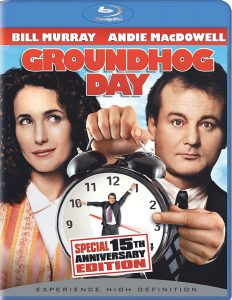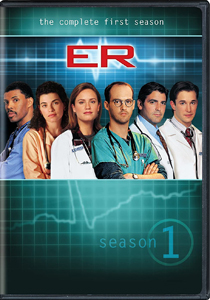Michael Crichton only wrote one episode of “ER,” the very first one in 1994. But among all his works of fiction, it’s the biggest window into his life. He wrote it as a film screenplay in the 1970s, but couldn’t get it made until after the success of “Jurassic Park.”
Steven Spielberg’s company launched the show, which ran for 15 seasons and was TV’s highest rated program for a while. That gave Crichton a No. 1 TV show, film (“Jurassic Park”) and book (“Disclosure”) within a year’s time, an achievement that’s not likely to be matched.
Controlled chaos
I know “24 Hours” (the pilot episode keeps the screenplay’s name) is a window into his life because I read “Travels” (1988), a collection of essays that is the closest thing to an autobiography from Crichton.

“ER: 24 Hours” (1994)
Director: Rod Holcomb
Writer: Michael Crichton
Stars: Anthony Edwards, George Clooney, Noah Wyle
In this 90-minute episode directed by TV veteran Rod Holcomb, it’s fun to see the real-life experiences that carry over to “ER.”
Trainee John Carter (Noah Wyle) has never inserted an IV before; Crichton was uncomfortable drawing blood. A patient is convinced he has cancer, even over Dr. Greene’s (Anthony Edwards) insistence that he does not; Crichton tells of such a patient in “Travels.”
Greene has coffee with a female colleague; Crichton did the same, and was annoyed about the whispers. Greene encounters a sexy and flirtatious patient; Crichton was assigned to a sex addict during his psych-ward training period.
Greene is in some ways the Crichton stand-in, except that “24 Hours” is about how Greene loves his work. Carter might also fit the stand-in bill, except that he also digs the gig. He particularly marvels at witnessing a baby’s birth.
Crichton, on the other hand, got into medicine to have a steady job. He was thrilled when he could leave it for a writing career.
A day on the job
“24 Hours” provides plenty of arguments why no sane person could love it. The episode is bookended with Dr. Greene getting an hour of sleep at the start of one day-long shift and the start of the next. The editors cut from him dozing off to being awoken in a way that feels jarringly real.
It’s easy to see why this screenplay was rejected 20 years earlier. It chronicles a day in the life of a workplace, and while it gives us memorable characters, it does not resolve every plotline. That’s a no-no for mainstream Hollywood.
The cases of many patients are ongoing. And we see several weird moments that go no further, such as Carter finding out his next patient is a woman dressed as a sexy maid.
The episode shows the controlled chaos of an emergency room and enough thrills and successes that we understand how a certain personality type might love it. In that way, Greene is the de facto main character. He even has an arc of sorts. On his lunch break, he’s offered a much higher-paying job, but he won’t get to practice medicine as much.

Launching a franchise, and careers
Even for the tireless Greene, burnout seems to be a danger in this profession. Heck, maybe even acting in a hospital drama causes burnout. No one in “24 Hours” makes it through all 331 episodes of “ER.” Wyle comes closest, logging 254.
George Clooney — as pediatrician Doug Ross, who is good-looking and knows it – traded “ER” for superstardom midway through Season 5. In a fun bit of trivia, he also starred in the short-lived “E/R” 10 years prior.
Ross starts by being treated at his own ER for drinking too much, something that’s apparently a habit – and which must’ve come from something Crichton witnessed or heard about.
Despite the suggestion of alcoholism, Ross is good at his job (as is everyone we meet). A few snippets show how he’s great with kids. And one instance shows how he is unfazed by things that would ruin a non-doctor’s day: He gets vomited on by a patient and doesn’t so much as flinch.
Notable guest stars
Smaller roles in “24 Hours” provide additional fun. “Roswell’s” Shiri Appleby – who would later join the supporting cast of “ER” in a different role – plays a 13-year-old with an ectopic pregnancy.
She tells Carter she can’t be pregnant, but then admits to Dr. Benton (Eriq La Salle) that she has had intercourse. Did Benton somehow pose the question better than Carter did? Carter adds it to his list of inexplicable experiences. His overall Day One lesson is that on this job, the bizarre is routine.
William H. Macy, later a regular in David Mamet films, plays the ER’s top-notch surgeon. And Miguel Ferrer plays a 40-year-old who learns he has terminal lung cancer.
In a scenario where a doctor has to deliver bad news, obviously the patient is worse off. But “24 Hours” makes a case that the accumulation of all those times a doc has to dispatch crushing information can wear on them.
There’s no textbook way to do it, as Crichton says in one of his “Travels” essays, although honesty is a good start. Ferrer’s character thanks Dr. Lewis (Sherry Stringfield) for giving it to him straight.
Background details
The writing is noticeably Crichtonian in the way exposition is peppered in. I can see it happening, and it’s not exactly subtle, but it is believable. A nurse stands by as Greene examines a female patient, and he tells her (and therefore the audience) it’s hospital policy. “Travels” tells us it’s to guard against charges of sexual misconduct by a doctor.
Other details come from backgrounds or quick mentions. The lounge and cafeteria find doctors sleeping. Brief jaunts into the late Chicago winter find doctors marveling at the fact that it’s snowing, and later raining.
Time moves fast in the ER, and people perpetually scurry, but the outdoors isn’t a place they spend much time until their long shifts end.
“24 Hours” mostly feels like the 1990s, but that’s because we see familiar actors when they were younger. The story could be set in the 1970s, or today – just adjust the technology to be older or newer.
A ‘timeless’ capsule
The episode isn’t particularly topical for 1994. The closest example might be that Ferrer’s heavy smoker has developed lung cancer, as anti-smoking campaigns were mainstream by that time. Meanwhile, the doctors’ steady coffee drinking is played as more of a joke: No one wants to have to make the next pot.
Some small things wouldn’t make it into a modern series without alteration. Ross’ post-binge-drinking treatment is one example (although Greene is not impressed by this habit, and I assume Ross’ behavior gets addressed in future episodes).
Later, a patient openly admits to smacking his wife around, but the thread ends in a punchline: His clenched fist is the right posture for Carter to find a vein for the IV drip.
On the other hand, we get a snippet about a mother battering her infant, leading to the one scenario where Ross feels he can judge and lecture a hospital visitor.
We meet characters who viewers will want to follow into future episodes – and we know they did. Nonetheless, “24 Hours” can stand on its own, as was Crichton’s initial intent. It’s a “timeless” capsule of what a day in the emergency room is like.

